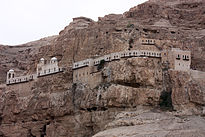- Monastery of the Temptation
-
 The monastery is located on the cliffs overlooking Jericho.
The monastery is located on the cliffs overlooking Jericho.
The Monastery of the Temptation (Greek: Μοναστήρι του Πειρασμού, Arabic: دير القرنطل Deir al-Quruntal) is an Orthodox Christian monastery located in the West Bank, along a cliff overlooking the city of Jericho and the Jordan Valley. It is built upon the summit of the Mount of Temptation, rising 350 meters above sea level.[1] It currently serves as a tourist attraction and its land is under the full jurisdiction of the Palestinian National Authority, but the monastery is owned and managed by the Orthodox Church of Jerusalem.
Contents
History
The earliest monastery was constructed by the Byzantines in the 6th century CE above the cave traditionally said to be that where Jesus spent forty days and forty nights fasting and meditating during the temptation of Satan,[2][3] about three kilometers northwest of Jericho. The monastery receives its name from the mountain which the early Christians referred to as the "Mount of the Temptation". The Monastery of the Temptation was identified by Augusta Helena of Constantinople as one of the "holy sites" in her pilgrimage in 326 CE.[4]
Palestine, including Jericho, was conquered by the Arabs under the Islamic Caliphate of Umar ibn al-Khattab in the 630s. When the Crusaders invaded the area in 1099, they built two churches on the site: one in a cave half way up the cliff and the second one on the summit.[1] They referred to the site as "Mons Quarantana" (from Quaranta meaning forty, the number of days in the Gospel account of Jesus's fast).[5][4]
The land upon which the modern monastery was built was purchased by the Orthodox Church in 1874. In 1895, the monastery was constructed around a crude cave chapel that marks the stone where Jesus sat during his fast.[5][2][1] Three Orthodox monks currently dwell in the monastery and guide visitors to the site.[2]
The Orthodox Church, along with its Palestinian Orthodox followers purchaser, originally attempted to build a church at the summit, but were unsuccessful; the unfinished walls of that church are located on a slope above the monastery. At this site, a fortress built by the Seleucids called "Doq" stood until it was captured by the Hasmoneans. It was here that Simon Maccabaeus was murdered by his son-in-law Ptolemy.[5]
See also
References
- ^ a b c Deir Quruntal & the Monastery of Temptation Visit Palestine.
- ^ a b c Lee, 2002, p. 346.
- ^ Matt 4:11–1
- ^ a b Jericho – Monastery of Temptation (Quarantal Monastery) Flickr.
- ^ a b c Jacobs, 1998, pp. 425–426.
Bibliography
- Jacobs, Daniel. Eber, Shirley. (1998) Israel and the Palestinian Territories Rough Guides. ISBN 1858282489
- Lee, Risha Kim. (2002) Let's Go 2003 Israel and the Palestinian territories Let's Go Incorporate. ISBN 031230580
Coordinates: 31°52′28.71″N 35°25′55.74″E / 31.8746417°N 35.43215°E
Religious Sites in the Palestinian Authority Ancient synagogue (Gaza) · Burqin Church · Church of the Nativity · Mosque of Omar (Bethlehem) · Cave of the Patriarchs† · Joseph's Tomb · Jacob's Well · Al-Khadra Mosque · Great Mosque of Nablus · An-Nasr Mosque · Tomb of Lazarus (al-Eizariya) · Tomb of Joshua · Great Mosque of Gaza · Monastery of the Temptation · Shalom Al Yisrael Synagogue · Mount Gerizim · Mount Ebal
† Although the Cave of the Patriarchs rests in Area A of the West Bank, access to the site is controlled by Israel.Categories:- 1895 architecture
- Greek Orthodox monasteries
- Christian monasteries in the West Bank
- 19th-century Christian monasteries
Wikimedia Foundation. 2010.

